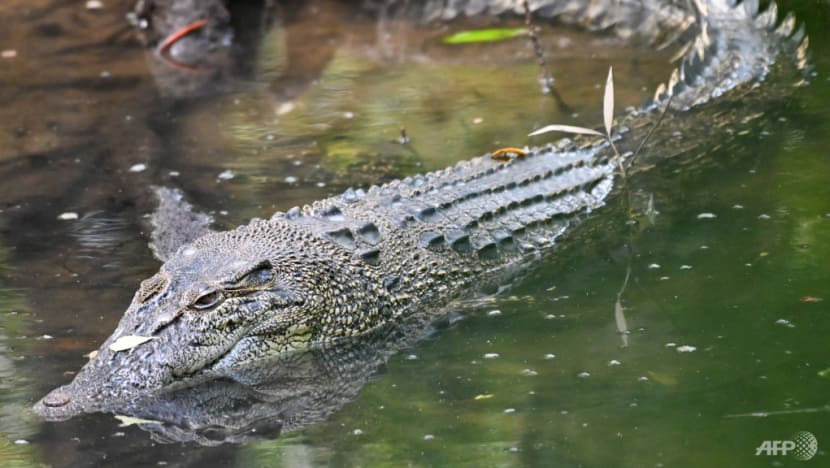CNA Explains: How common are crocodiles in Singapore and why was the one found on a beach put down?
What should you do if you encounter a crocodile?

A saltwater crocodile is seen in the water at Sungei Buloh Wetland Reserve in Singapore on Feb 2, 2021. (File photo: AFP/Roslan Rahman)
SINGAPORE: Every once in a while, Singapore gets a reminder that the term "a City in Nature" is not just a tourism slogan or a lofty civic goal but a very real description.
The latest reminder arrived on a beach at Marina East Drive this week in the form of a nearly 3m-long crocodile.
In the interest of public safety, the reptile was trapped and subsequently put down on Thursday, the National Parks Board (NParks) confirmed on Friday (Oct 13).
Why did the situation pan out this way? How common are crocodiles in Singapore?
CNA spoke to NParks, the Mandai Wildlife Group and the Herpetological Society of Singapore (HSS), a group of reptile and amphibian enthusiasts.
Why was the crocodile put down?
According to NParks, there are three reasons why this had to be done.
First, the crocodile was "relatively large".
While a crocodile made headlines when it was relocated to Sungei Buloh Wetland Reserve from East Coast Park in 2021, it was smaller, at about half the length of the crocodile captured this week.
The smaller crocodile "was assessed to be of a lesser risk to public safety", NParks director for wildlife management and outreach How Choon Beng said in a statement on Thursday.
Second, NParks no longer deems Sungei Buloh to be a suitable release site as it now has a "large population of crocodiles".
Based on ongoing surveys, there are currently about 20 crocodiles at the reserve, Mr How said in response to CNA's queries on Friday.
Third, there was a risk that the crocodile could return to the location where it was captured, which is near East Coast Park, a popular beachfront recreational destination.
"When there are sightings of crocodiles in Singapore, the National Parks Board will assess if there is a threat to public safety," said Mr How.
"For example, if the location is a recreational destination accessible to public, NParks will trap and remove the crocodile in the interest of public safety. Relocation and rehoming options will be explored first."
If there are no options, the crocodile will be humanely put down.
Could the crocodile have been placed in a zoo?
If there was no place in the wild for the crocodile that would have allayed public safety concerns, then a new home at the zoo might have seemed like an alternative. That was not the case.
When it comes to zoo population management and planning, multiple factors have to be considered carefully, a spokesperson for the Mandai Wildlife Group told CNA.
"Ultimately, we must be satisfied that the outcome would favour the animal regarding quality of life and welfare as well as have no negative effects to our institutional population planning and conservation commitments," the spokesperson said.
"In this case, we determined we will not be able to rehome this individual in a way that meets these criteria."

What type of crocodile was it?
The crocodiles found in Singapore are estuarine crocodiles, also known as saltwater crocodiles, and scientifically as Crocodylus porosus. They are among the largest crocodile species on the planet and males can grow to more than 5m in length.
According to the website for the Our Wild Neighbours initiative, saltwater crocodiles have been documented around the Indian subcontinent, across Southeast Asia, along the northern coastline of Australia and as far east as Fiji.
"Estuarine crocodiles feed and rest in brackish and freshwater areas and are usually found in the water or on mudflats away from visitor routes," Mr How said.
"They hunt mainly at night and in Singapore, feed mostly on fish, which is its most abundant prey."
Saltwater crocodiles were assessed to be of "least concern" in the International Union for Conservation of Nature Red List of Threatened Species for 2019 – this is the lowest level on the list, meaning that they have an abundant and widespread population.
However, the species is considered to be critically endangered locally, said HSS president Kannan Raja.
How did the crocodile end up where it did?
Given that the range of saltwater crocodiles spans South Asia, Southeast Asia and Oceania, the origin of the crocodile cannot be pinpointed without more information, Mr Kannan told CNA.
"It could have strayed from its home territory in Sungei Buloh, southern Johor or even the Riau archipelago if it is a transient individual," he said.
"Some individuals of this species have been recorded moving hundreds of kilometres within a month in Australia.
"As a transient individual, it could have just been passing by and not looking to move into Singapore permanently. If it were not transient, this crocodile could have been the Marina East Drive beach area's resident or territory holder."
According to Our Wild Neighbours, crocodiles are territorial creatures, and large males will chase away other males while allowing females to stay in their area.
Mr Kannan added that the only permanent crocodile population that HSS knows of is found around Sungei Buloh.
"While crocodiles do pop up in other parts of the island from time to time, these individuals are not considered to be part of a new population," he said.

What should you do when you see a crocodile?
Anyone who encounters a crocodile should remain calm and back away, Mr How said.
"They should not approach, provoke, or feed the animal. They should also heed warning signs and advisory notices that have been posted at areas where crocodiles have been sighted," he added.
Not sure if it is a crocodile or a monitor lizard? Mr Kannan said that size is often a good indicator.
"Our Malayan water monitors tend to stay at about 2m in length, while the crocodiles can double or even triple that for some males," he said.
"Large armour-like scales and exposed teeth are a dead giveaway for a saltwater crocodile; monitors have scaly skin with a leathery look, and their teeth are not exposed when the mouth is closed.
"Lastly, the location can also help identify if you are looking at a saltwater crocodile or a Malayan water monitor. If you are standing by a neighbourhood park or garden pond, you are most likely in the company of the monitor lizard."


















